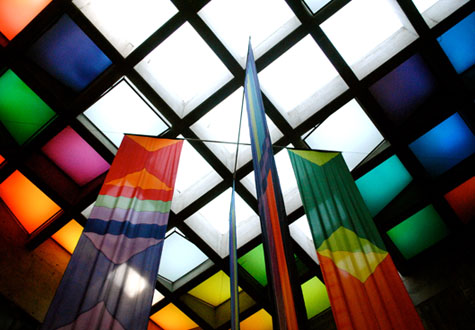After spending the last several semesters on an urban “campus” in downtown Montreal, I was thrilled to get back to a real campus with grass and trees and an actual history behind it. Therefore, for this entry I have attempted to educate myself a tiny bit about my new school. Established in 1878 as a denominational school of the Church of England, the University of Western Ontario was designed at the height of the morally-driven Gothic revival in architecture. One of the first two buildings constructed at the site, University College is a massive gray stone structure that is also one of the most recognized symbols of the school (figure 1). Set on a sloping expanse of lawn with a single path leading up to its front doors (which, I must say, lends to an inflated sense of self-importance when making the ascent to class), University College is an imposing yet beautiful structure located at the very center of the campus.
Conron Hall, the large lecture hall and theatre on the second floor of University College is definitely steeped in history, as its original purpose was as the convocation hall. As you approach the large double doors to enter the space, there are signs everywhere reminding visitors that food and drink is absolutely forbidden inside–setting a more formal tone for the space. As I stepped through the doors, my gaze immediately turned upward to a coffered ceiling dotted with pot lights. The walls are covered in heavy wood panelling, with a portrait painting haphazardly hung on the right wall. A low stage at the front of the room is accompanied by several sets of heavy black stage lights suspended from the ceiling and flanking the stage. There is a lot of clutter occupying the space. Quite frankly, my first impression of the room was a sense of being overwhelmed and a bit confused. In order to process the space entirely, I took a seat in the middle of the theatre-style seating and attempted to hone my observational skills.
I believe the style the designers were aiming for was mostly Gothic. The entire exterior wall of the room is comprised of stained glass, with many different coats of arms represented in the windows and a few recurrent motifs, such as the fleur-de-lis. I am certain that there is significant symbolism at work here, but I am not privy to the codes to decipher them. Regardless, the presence of all these symbols creates an air of exclusivity, authority and ceremony within the room. On the other wall, there are several different materials being used: wood, plaster, concrete, and wrought iron. The sectioning of the wall is reminiscent of William Morris’ Green Dining Room. There is a second floor corridor running along the interior wall and beyond that, a set of frosted glass windows that look down into the hall. The railings that line the walkway are made of iron and are cross-themed, which could be the original design as the school was a Christian institution until 1908. The way the wall is divided into sections, the presence of a detailed ceiling, the use of relatively unadorned surface materials, and the stained glass tracery windows all indicate a Gothic objective. Strangely though, there are also engaged columns (figure 2) that feature a Corinthian-style vine decoration which continues across the second-floor balcony. Where did this random Greek influence come from? I was baffled.
Now, while the room is initially striking, my first impression quickly began to shift. I wasn’t sure exactly how I felt in my seated position in the middle of the hall. I immediately quieted my voice because I felt alternately like I was in a church or watching a theatre production (perhaps because there was an ongoing drama rehearsal - but who knows) (figure 3). The seating area is rather unattractively carpeted and I am not sure why this addition was necessary, when the rest of the hall is hardwood. The cushy seats are similar to those in an entertainment venue but they also have pull out desks for students, so the space is obviously used for both lectures and leisure. I wish that the hall could commit to being one or the other. It would be a privilege to learn in a space as beautiful as Conron Hall, and granted, there are upgrades that are necessary to create a proper lecture hall, but I wish the transition was more discreet. The Corinthian design on the balcony literally frames a modern, plain square clock that has been added for the convenience of the occupants. There are glaring red exit signs over the beautifully carved double doors. Several white, half-dome lights hang from the ceiling, but clash with the two existing antique chandeliers. I feel like there must be a way to have a beautifully preserved neo-Gothic classroom that achieves its full potential by wholly committing to one style–new or old, and therefore encouraging the users to commit to a code of behaviour as well.
|













